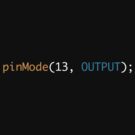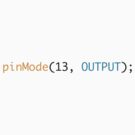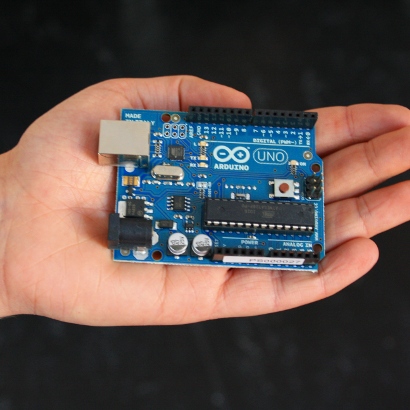Nerdy, geeky. I made an Arduino t-shirt design. You can buy it as a tee a hoodie a vest or a sticker on RedBubble. I don't know why, but white ones are cheaper.
CakePHP programming with some other stuff like Hackintosh (OSx86) and, more recently, Coldfusion.
28 Dec 2010
26 Dec 2010
Arduino!
I bought my self an Arduino for Christmas. Why? Wtf is an Arduino?
Very simply put, an Arduino is a small, programmable computer on a tiny circuit board with built in interfaces. Yeah. What do you do with it? Well, probably almost anything you can think of. Common uses are in robotics and control. Some applications I have in mind are:
Very simply put, an Arduino is a small, programmable computer on a tiny circuit board with built in interfaces. Yeah. What do you do with it? Well, probably almost anything you can think of. Common uses are in robotics and control. Some applications I have in mind are:
- temperature and humidity control for my egg incubator
- enlarger timer and controller for film photography
- flight management system for a tri-rotor helicopter
Okay, it's really nerdy. But it's also electronics for programmers. The Arduino is programmed using C. That might seem scary, but if you've ever programmed javascript, java or PHP, you'll feel pretty comfortable.
Arduino themselves describe it as "...an open-source electronics prototyping platform based on flexible, easy-to-use hardware and software. It's intended for artists, designers, hobbyists, and anyone interested in creating interactive objects or environments."
You have the ability to easily interface sensors (data input) and analog or digital outputs, e.g. motors and LCD displays. Expanding this, I can use temperature and humidity sensors to turn the incubator heater on and off. Light sensors to measure a film exposure and display the result on an LCD display or gyro, and GPS to autonomously control a model helicopter.
The variety of sensors available is huge and there are ready made software libraries to do almost anything you can think of.
So it must be expensive. Not at all. My starter kit cost about £33 and included a genuine Arduino Uno (more about genuine in a moment), 60 LEDs and a pile of other components. I bought it from Earthshine Electronics but there are dozens of other companies with their own deals.
Arduino is an open-source project and that extends to the hardware as well, so you can get Seeduino, Freeduino (not free!) etc. clone boards. In general, they're all 100% compatible. You can even build your own. The boards on their own mostly cost from £10 - £30.
You have the ability to easily interface sensors (data input) and analog or digital outputs, e.g. motors and LCD displays. Expanding this, I can use temperature and humidity sensors to turn the incubator heater on and off. Light sensors to measure a film exposure and display the result on an LCD display or gyro, and GPS to autonomously control a model helicopter.
The variety of sensors available is huge and there are ready made software libraries to do almost anything you can think of.
So it must be expensive. Not at all. My starter kit cost about £33 and included a genuine Arduino Uno (more about genuine in a moment), 60 LEDs and a pile of other components. I bought it from Earthshine Electronics but there are dozens of other companies with their own deals.
Arduino is an open-source project and that extends to the hardware as well, so you can get Seeduino, Freeduino (not free!) etc. clone boards. In general, they're all 100% compatible. You can even build your own. The boards on their own mostly cost from £10 - £30.
22 Dec 2010
Git links
Trying to find the answer to this question, "Git bare - what to backup?" threw up some useful links:
How to manage a website with Git
The Git object model
How Git stores objects
How to manage a website with Git
The Git object model
How Git stores objects
3 Dec 2010
Helping clients understand web designers
I have a friend who is about to become a client. He asked me to recommend a book that will teach him enough about web design, without actually ramming the how-to down his throat, to be able to know what can be done and how to communicate his needs and ideas.
Now normally it would be the job of the designer to tease this information from the client without him having to be exposed to the jargon. This chap, though, genuinely wants to know and to understand and I don't have a problem with that. I think it'll make him a better client.
Actually finding a book to recommend is not easy. So far all I have come up with is Web Design All-in-one For Dummies which I think will probably cover stuff he needs to know, but again it's probably too technical.
which I think will probably cover stuff he needs to know, but again it's probably too technical.
Any other suggestions?
Now normally it would be the job of the designer to tease this information from the client without him having to be exposed to the jargon. This chap, though, genuinely wants to know and to understand and I don't have a problem with that. I think it'll make him a better client.
Actually finding a book to recommend is not easy. So far all I have come up with is Web Design All-in-one For Dummies
Any other suggestions?
1 Dec 2010
fruit
Testing the link between Flickr and Blogger.
If you want to link your Flickr and Blogger accounts watch this video: http://www.flickr.com/photos/ivanwalsh/3504011106/
You can choose whether you share a photo - it doesn't automatically share everything.
If you want to link your Flickr and Blogger accounts watch this video: http://www.flickr.com/photos/ivanwalsh/3504011106/
You can choose whether you share a photo - it doesn't automatically share everything.
<pre> and <code> in blogger blogs
It seems that the best way to post code in a blogger blog is by encoding the chevrons '<>' and ampersands '&' using something like http://centricle.com/tools/html-entities/
Some styles are needed in the template and you have to wrap the code up in <pre>...</pre> or <code>...</code>
Some styles are needed in the template and you have to wrap the code up in <pre>...</pre> or <code>...</code>
The Coldfusion Blog Tutorial
There may well be one out there, but I didn't look too hard.
Today, snowbound at home, I am adapting the CakePHP blog tutorial to Coldfusion. The only difficulties will be that cakePHP & MVC makes a lot of things very easy, but doing it in CF is going to be very 'hands on'. At least I'll get a lot of low-down experience with CF.
If it proves to be interesting or useful and if I have the time or the inclination, I may well publish it for the benefit of other CF newcomers.
Today, snowbound at home, I am adapting the CakePHP blog tutorial to Coldfusion. The only difficulties will be that cakePHP & MVC makes a lot of things very easy, but doing it in CF is going to be very 'hands on'. At least I'll get a lot of low-down experience with CF.
If it proves to be interesting or useful and if I have the time or the inclination, I may well publish it for the benefit of other CF newcomers.
Subscribe to:
Comments (Atom)





